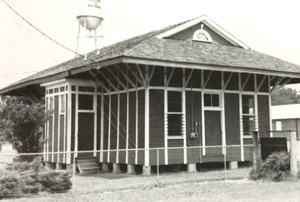A LITTLE PIECE OF HISTORY | By Joan Frances –

Business was brisk in downtown Richmond during the 1890s. The store fronts of downtown business faced the railroad tracks so wagons easily could be loaded along Calhoun Street. Photo by Fort Bend County Texas, A pictorial History.
In the historic past of Fort Bend County, the single most significant influence on the increase of transportation, commerce and growth for every city in the area was the railroad. When the Buffalo Bayou, Brazos and Colorado Railroad were chartered on February 11, 1850, communities were built around the railway system. The city of Richmond built a train depot, and it served as a primary entryway for social and economic progress linking the city of Richmond to the outside world.
During the industry’s “Golden Age” (through World War I), over 80,000 depots across the country were in service. The Richmond train depot was the town’s lifeline, and the only connection to the other cities. This small, but efficient building proved to be the heart of the community. Residents would mingle around the depot at all hours of the day awaiting incoming news. Dressed in her Sunday clothes, Grandma can still remember sitting on a wooden bench anxiously waiting for the boarding call to visit a family member. This depot also served as a valuable connection for commodities shipped into and out of the city.

The Galveston, Harrisburg and San Antonio depot sits in downtown Richmond awaiting restoration. Richmond has had many of its historic buildings restored, and they are open to the public to capture the flavor of lifestyle in early Fort Bend County. Photo by Railroads of Fort Bend County.
The railroad agent/operator was essential to managing the day to day operations. The cost of a passenger train ticket was two to three cents per mile. Usually one man sold and collected the tickets. He would also notify the other stations, using telegraph and later telephone, when the train reached their location by a two letter “on sheet” report identification. A large hoop mounted near the tracks notified the head crew, usually the fireman, and the caboose, typically the flagman, of any orders which required the train to physically stop. Three copies of these orders went to the office, engineer (head-end) and the conductor (caboose). This proved to be a successful procedure, to ensure redundancy, safety and that the orders were clearly understood. The fireman would put his arm out of the cab of the locomotive and grab the loop as they went by. It was truly a skill for the crewman to grab this report at fast speeds. Sometimes they missed, then the train would be required to stop, and the crewman would walk back to obtain the order. Later, the train depot updated this method with a modern light system, featuring green, yellow or red lights.
Train depots were designed in different sizes and architectural styles. The Richmond depot served as a small facility while the reference to “station” was affiliated with large structures such as Grand Central Station in New York or Chicago’s Dearborn Station. During the 20th century, structures were built with attention to detail, stylish and elegant, designed to make a statement for the area. Unfortunately, as cities grew, many of these historic buildings were demolished. The Richmond depot was built entirely of wood, carrying steep roof lines and decorative touches. Most of the railroad depots in Fort Bend County were built out of wood, others were stucco, plaster or an adobe structure.
Originally located on the southwest corner of 7th and Calhoun Street, the 1901 Richmond train depot was relocated to Decker Heritage Park in 1977. To preserve this significant piece of history, the designated plot of land in downtown Richmond is also home to the 1850’s McNabb house, and the 1896 Kochan-Reed home. A water tower and gazebo on the grounds add to the memories of a bygone era. This historic landmark will forever remind the community of the importance of the railroad depot and the meaningful legacy of the City of Richmond.